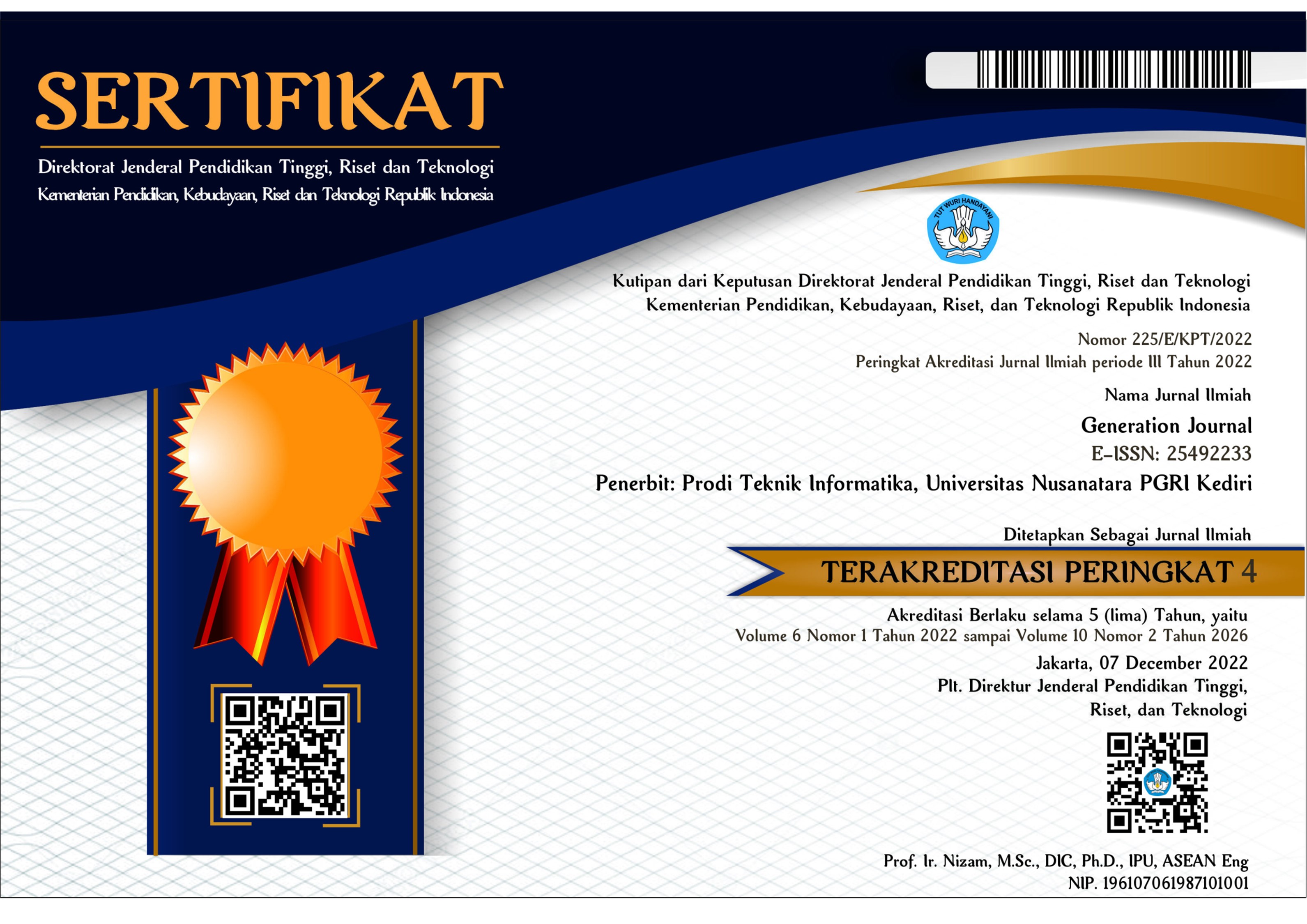Klasifikasi Citra Aksara Lontara menggunakan K-NN dan Ekstraksi Fitur HOG
DOI:
https://doi.org/10.29407/gj.v8i2.22580Keywords:
K-NN, Histogram of Oriented Gradients, Aksara LontaraAbstract
Indonesia boasts a diverse cultural heritage, one of which is the regional languages that possess unique scripts across the archipelago. An example of this is the Lontara script, used by the Bugis and Makassar communities. The Lontara script is one of the scripts in Indonesia that is endangered due to the passage of time. The K-Nearest Neighbors (K-NN) algorithm can be a tool used to recognize patterns in the Lontara script. The principle of K-NN is quite simple, namely matching the similarity of new data with the nearest test data. In this research, K-NN is used for classification and Histogram of Oriented Gradients (HOG) for feature extraction. Based on the research conducted using a testing scheme with an image size of 32×32 pixels, a dataset split of 90:10, and a k-value of 5, an accuracy result of 0.8525 was obtained.
References
[2] N. M. Putry and B. N. Sari, "KOMPARASI ALGORITMA KNN DAN NAÏVE BAYES UNTUK KLASIFIKASI DIAGNOSIS PENYAKIT DIABETES MELITUS," Evolusi: Jurnal Sains dan Manajemen, vol. 10, no. No. 1, pp. 45-57, 2022.
[3] F. Bimantoro, A. Aranta, G. S. Nugraha, R. Dwiyansaputra and A. Y. Husodo, "Pengenalan Pola Tulisan Tangan Aksara Bimamenggunakan CiriTekstur dan KNN," J-COSINE, vol. 5, no. No. 1, pp. 60-67, 2021.
[4] R. Yulianti, G. P. S. Wijaya and F. Bimantoro, "Pengenalan Pola Tulisan Tangan Suku Kata Aksara Sasak Menggunakan Metode Moment Invariant dan Support Vector Machine," J-COSINE, vol. 3, no. No. 2, pp. 91-98, 2019.
[5] R. K. Wati and H. Irsyad, "Pengenalan Aksara Arab Menggunakan Metode JST Dengan Fitur HOG Dan LBP," Jurnal Algoritme, vol. 2, no. No. 1, pp. 39-54, 2021.
[6] F. Syuhada, "KLASIFIKASI CITRA TULISAN TANGAN AKSARA SASAK DENGAN METODE HISTOGRAM OF ORIENTED GRADIENTS DAN MULTINOMIAL LOGISTIC REGRESSION," JITET, vol. 11, no. No. 3, pp. 604-613, 2023.
[7] "Penerapan Convolutional Neural Network (CNN) pada Pengenalan Aksara Lampung Berbasis Optical Character Recognition (OCR)," JEPIN, vol. 7, no. No. 1, pp. 52-57, 2021.
[8] F. T. Anggraeny, Y. V. Via and R. Mumpuni, "Image preprocessing analysis in handwritten Javanese," Bulletin of Electrical Engineering and Informatics, vol. 12, no. No. 2, pp. 860-867, 2023.
[9] A. R. Widiarti and H. Suparwito, "Analisis Unjuk Kerja K-Nearest Neighbour untuk Klasifikasi Citra Aksara Bali Tulis Tangan," Indonesian Journal of Electronics and Instrumentation Systems (IJEIS), vol. 12, no. No.2, pp. 123-132, 2022.
[10] V. Oktavia and N. Wijaya, "Pengenalan Tulisan Tangan Huruf Latin Bersambung Menggunakan Local Binary Pattern dan K-Nearest Neighbor," Jurnal Informatika Sunan Kalijaga, vol. 7, no. No. 3, pp. 211-225, 2022.
[11] A. F. Rabda, N. Suciati and D. A. Navastara, "Implementasi Metode Kombinasi Histogram of Oriented Gradients dan Hierarchical Centroid untuk Sketch Based Image Retrieval," JURNAL TEKNIK ITS, vol. 5, no. No. 2, pp. A311-A316, 2016.
[12] Y. Sugianela and N. Suciati, "Ekstraksi fitur pada pengenalan karakter Aksara Jawa berbasis Histogram of Oriented Gradient," Jurnal Ilmiah Teknologi Informasi, vol. 17, no. No. 1, pp. 64-72, 2019.
[13] I. I. Saputri, Purnawansyah and Herman, "Implementasi Metode Naïve Bayes Pada Pengenalan Tulisan Tangan Lontara," Buletin Sistem Informasi dan Teknologi Islam, vol. 2, no. No. 3, pp. 167-175, 2021.
[14] A. R. Widiarti, "Unjuk kerja k-nearest neighbor untuk alihaksara citra aksara Nusantara," Jurnal Teknologi dan Sistem Komputer, vol. 8, no. No. 2, pp. 150-156, 2020.
[15] P. Ginting, H. Rumapea, A. P. Silalahi, P. Lumbanraja and M. Aritonang, "Pengenalan Pola Aksara Karo Berdasarkan Citra Pola Menggunakan Metode K-Nearest Neighbor," Methotika : Jurnal Ilmiah Teknik Informatika, vol. 2, no. No. 1, pp. 38-45, 2022.
[16] I. P. R. Anandya, I. G. A. G. A. Kadyanan, I. D. M. B. A. Darmawan, C. R. A. Pramartha, A. A. I. N. E. Karyawati and N. A. S. ER, "Klasifikasi Aksara Bali Berbasis Suara Dengan Metode KNN dan FastDTW," Jurnal Elektronik Ilmu Komputer Udayana, vol. 11, no. No. 3, pp. 581-586, 2023.
[17] S. Alfarisi and Subandi, "Implementasi Pengenalan Aksara Bali Menggunakan Direction Feature Extraction dan K-Nearest Neighbor," Jurnal TICOM, vol. 11, no. No. 1, pp. 50-54, 2022.
[18] M. Tyagi, "HOG (Histogram of Oriented Gradients): An Overview," 4 Juli 2021. [Online]. Available: https://towardsdatascience.com/hog-histogram-of-oriented-gradients-67ecd887675f.
Downloads
Published
Issue
Section
License
Authors who publish with this journal agree to the following terms:
- Copyright on any article is retained by the author(s).
- The author grants the journal, the right of first publication with the work simultaneously licensed under a Creative Commons Attribution License that allows others to share the work with an acknowledgment of the work’s authorship and initial publication in this journal.
- Authors are able to enter into separate, additional contractual arrangements for the non-exclusive distribution of the journal’s published version of the work (e.g., post it to an institutional repository or publish it in a book), with an acknowledgment of its initial publication in this journal.
- Authors are permitted and encouraged to post their work online (e.g., in institutional repositories or on their website) prior to and during the submission process, as it can lead to productive exchanges, as well as earlier and greater citation of published work.
- The article and any associated published material is distributed under the Creative Commons Attribution-ShareAlike 4.0 International License













